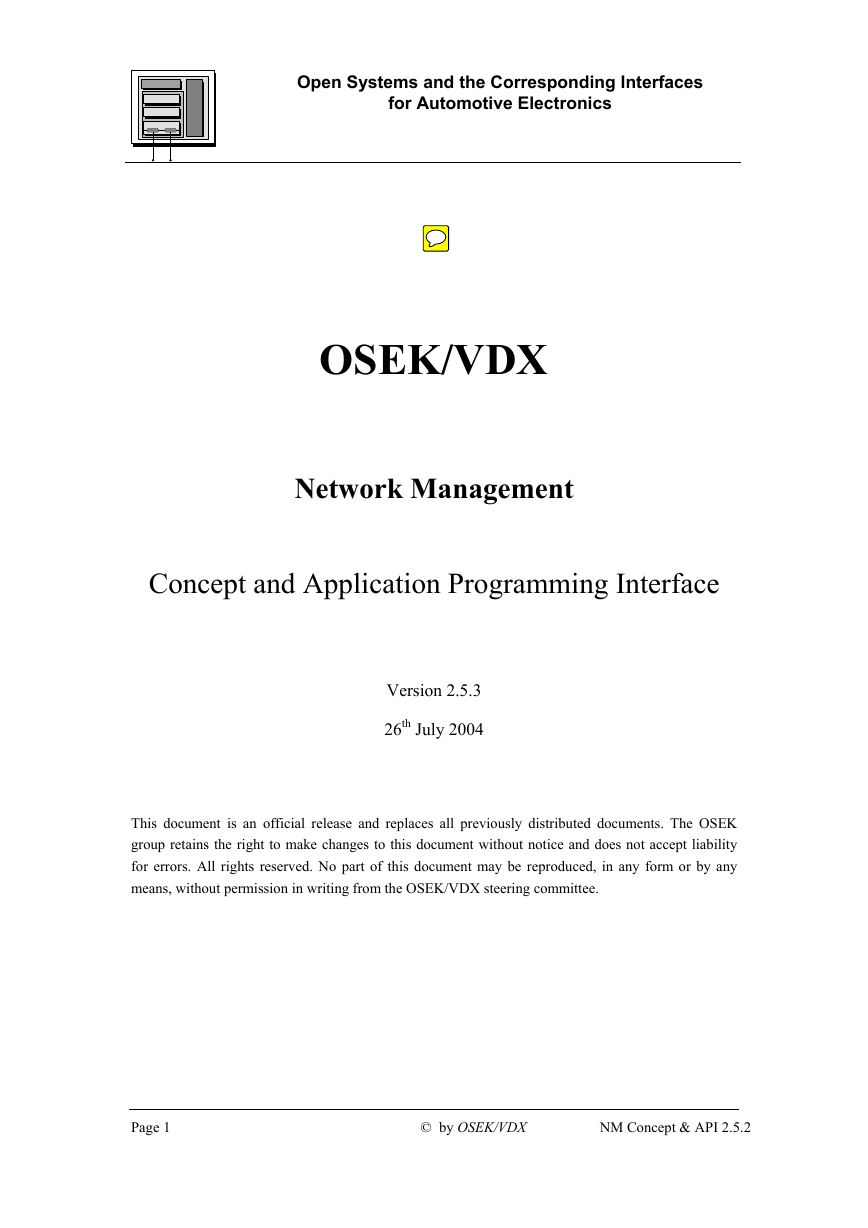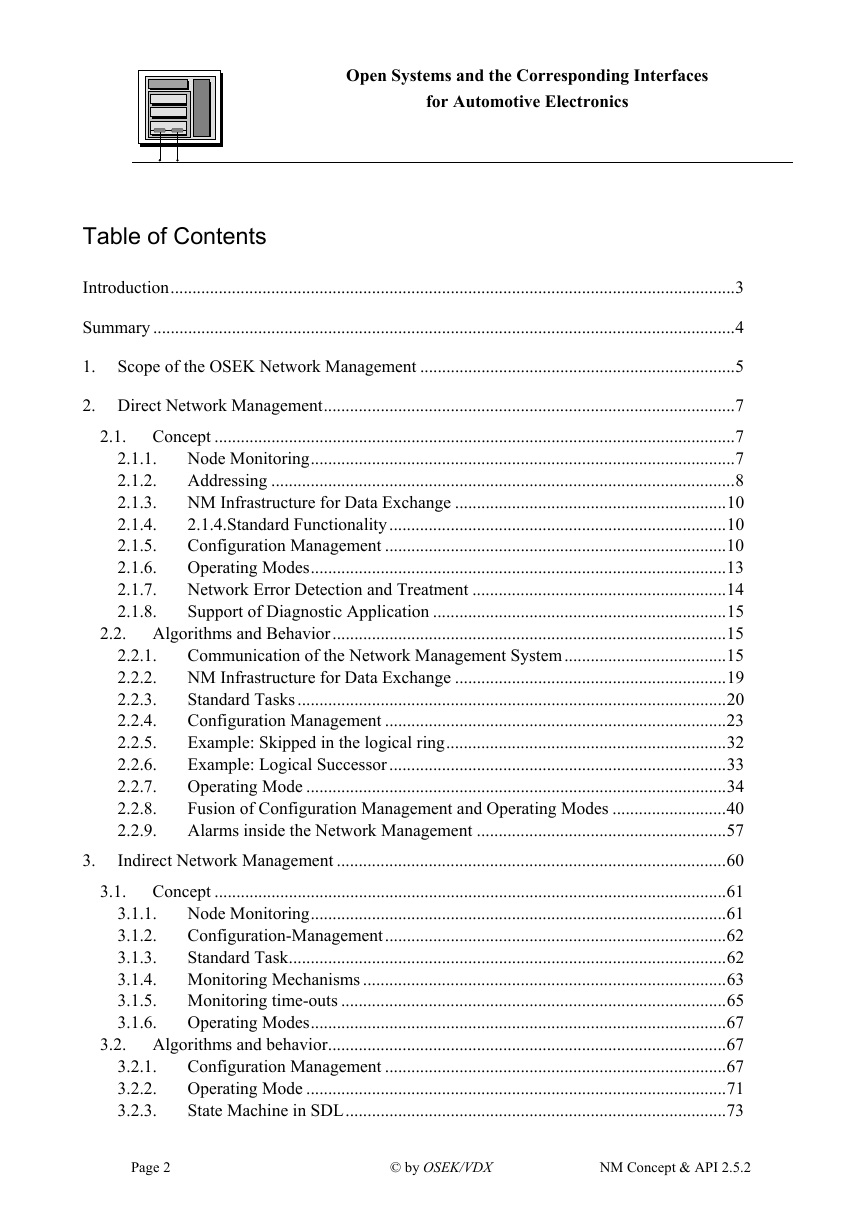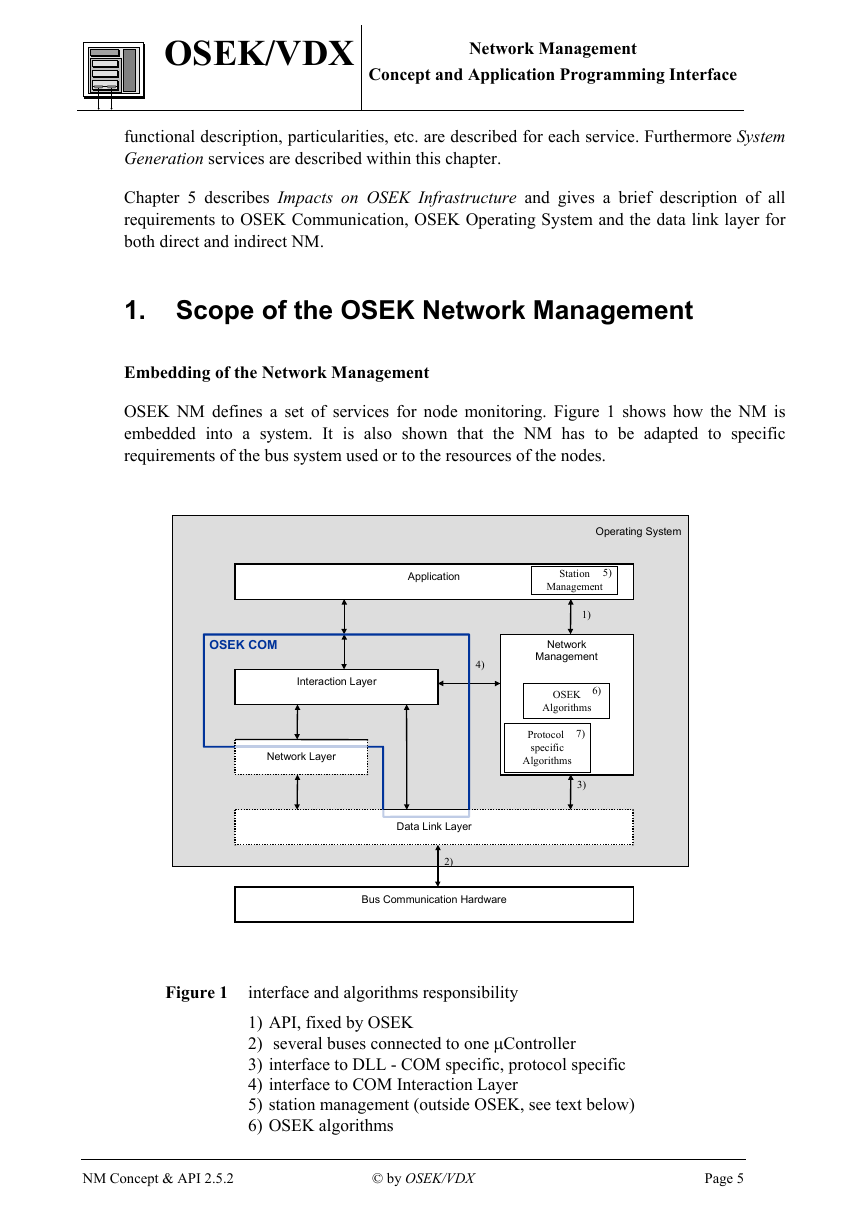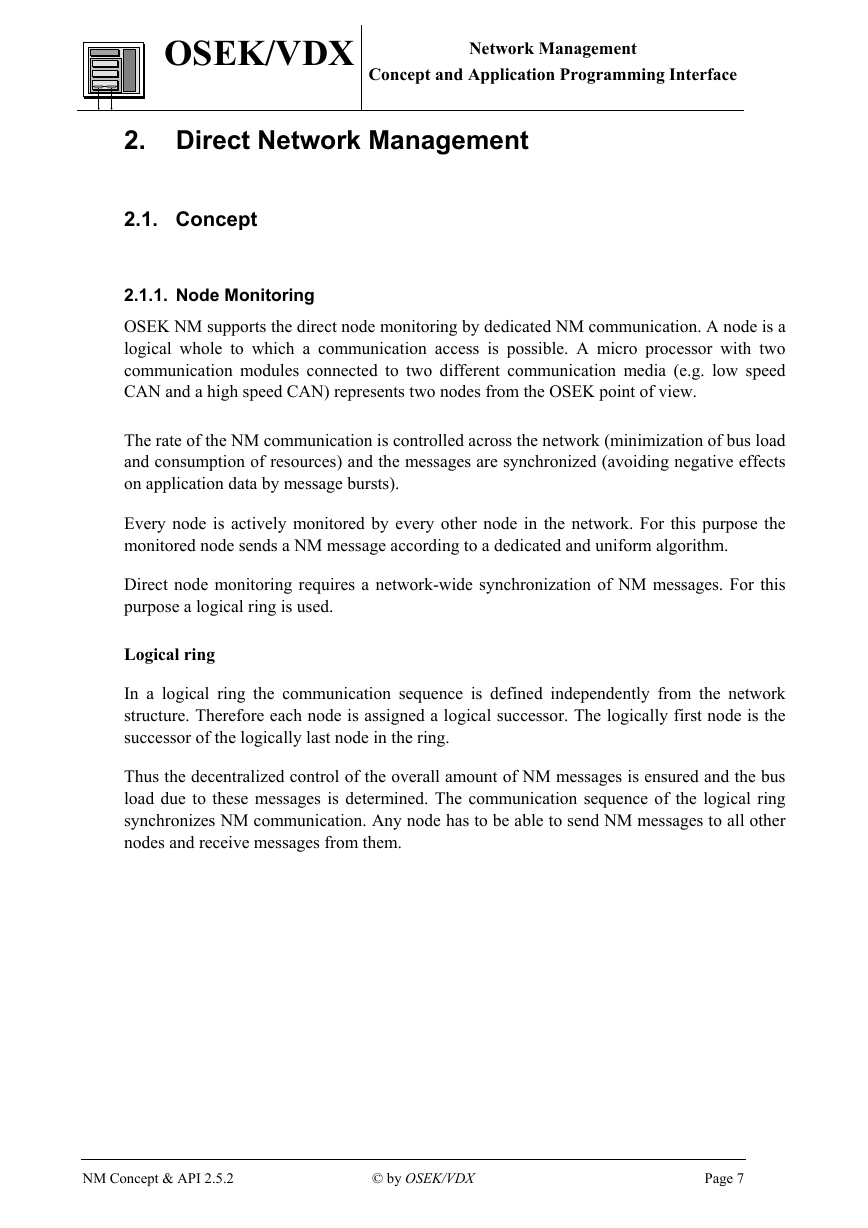Open Systems and the Corresponding Interfaces
for Automotive Electronics
OSEK/VDX
OSEK/VDX
Network Management
Concept and Application Programming Interface
Version 2.5.3
26th July 2004
This document is an official release and replaces all previously distributed documents. The OSEK
group retains the right to make changes to this document without notice and does not accept liability
for errors. All rights reserved. No part of this document may be reproduced, in any form or by any
means, without permission in writing from the OSEK/VDX steering committee.
Page 1
© by OSEK/VDX
NM Concept & API 2.5.2
�
Open Systems and the Corresponding Interfaces
for Automotive Electronics
OSEK/VDX
Table of Contents
Introduction.................................................................................................................................3
Summary .....................................................................................................................................4
1. Scope of the OSEK Network Management ........................................................................5
2.1.1.
2.1.2.
2.1.3.
2.1.4.
2.1.5.
2.1.6.
2.1.7.
2.1.8.
2. Direct Network Management..............................................................................................7
2.1. Concept .......................................................................................................................7
Node Monitoring.................................................................................................7
Addressing ..........................................................................................................8
NM Infrastructure for Data Exchange ..............................................................10
2.1.4.Standard Functionality.............................................................................10
Configuration Management ..............................................................................10
Operating Modes...............................................................................................13
Network Error Detection and Treatment ..........................................................14
Support of Diagnostic Application ...................................................................15
2.2. Algorithms and Behavior..........................................................................................15
Communication of the Network Management System.....................................15
2.2.1.
NM Infrastructure for Data Exchange ..............................................................19
2.2.2.
Standard Tasks..................................................................................................20
2.2.3.
Configuration Management ..............................................................................23
2.2.4.
Example: Skipped in the logical ring................................................................32
2.2.5.
Example: Logical Successor .............................................................................33
2.2.6.
Operating Mode ................................................................................................34
2.2.7.
Fusion of Configuration Management and Operating Modes ..........................40
2.2.8.
Alarms inside the Network Management .........................................................57
2.2.9.
Indirect Network Management .........................................................................................60
3.1. Concept .....................................................................................................................61
Node Monitoring...............................................................................................61
3.1.1.
Configuration-Management..............................................................................62
3.1.2.
3.1.3.
Standard Task....................................................................................................62
3.1.4. Monitoring Mechanisms ...................................................................................63
3.1.5. Monitoring time-outs ........................................................................................65
3.1.6.
Operating Modes...............................................................................................67
3.2. Algorithms and behavior...........................................................................................67
Configuration Management ..............................................................................67
Operating Mode ................................................................................................71
State Machine in SDL.......................................................................................73
3.
3.2.1.
3.2.2.
3.2.3.
Page 2
© by OSEK/VDX
NM Concept & API 2.5.2
�
OSEK/VDX
OSEK/VDX
Network Management
Concept and Application Programming
Interface
4.5.
4.6.
4.5.1.
4.5.2.
4.5.3.
4.4.1.
4.4.2.
4.4.3.
4.2.1.
4.2.2.
4.2.3.
4.2.4.
4. System generation and API...............................................................................................85
4.1. Overview...................................................................................................................85
4.2. Conventions for Service Description........................................................................87
System Generation ............................................................................................87
Type of Calls.....................................................................................................87
Error Characteristics .........................................................................................87
Structure of the Description..............................................................................88
4.3. General Data Types...................................................................................................89
4.4. Common services......................................................................................................89
Standard Functionality......................................................................................89
Configuration Management ..............................................................................92
Operating Modes and Operating Mode Management.......................................98
Services for direct NM............................................................................................102
Standard Functionality....................................................................................102
Operating Modes and Operating Mode Management.....................................102
Data Field Management..................................................................................103
Services for indirect NM.........................................................................................106
Standard functionality.....................................................................................106
4.6.1.
Configuration Mangement ..............................................................................106
4.6.2.
Impacts upon OS, COM and the data link layer .............................................................107
5.1.
Error Codes .............................................................................................................107
5.2. Common impacts ....................................................................................................108
Requirements of the data link layer ................................................................108
Requirements of OSEK Operating System (OSEK OS).................................110
Impacts from direct NM..........................................................................................111
Interface to the data link layer ........................................................................111
Impacts from indirect NM.......................................................................................112
Interface to OSEK Communication (OSEK COM)........................................112
6. History.............................................................................................................................115
5.2.1.
5.2.2.
5.3.
5.4.
5.3.1.
5.4.1.
5.
Implementation proposal (direct NM) ............................................................................116
Overview of Internal Activities ......................................................................116
7.0.1.
Specification of Internal Activities .................................................................119
7.0.2.
NMPDU ..........................................................................................................124
7.0.3.
7.0.4.
Scalability .......................................................................................................129
Implementation proposal (indirect NM) .................................................................131
Scalability .......................................................................................................131
Implementation hints ......................................................................................132
Summary of SDL state diagram graphical notation........................................134
7.2. Outlook ...................................................................................................................135
Index ...............................................................................................................................137
7.1.1.
7.1.2.
7.1.3.
7.1.
7.
8.
Page 2
© by OSEK/VDX
NM Concept & API 2.5.2
�
OSEK/VDX
OSEK/VDX
Network Management
Concept and Application Programming Interface
Introduction
There is an increasing tendency for electronic control units (ECUs) made by different
manufacturers to be networked within vehicles by serial data communication links.
Therefore, standardization of basic and non-competitive infrastructure in ECUs aims at
avoiding the design of unnecessary variants and saving development time.
In the scope of the OSEK/VDX co-operation, the Network Management system (NM)
provides standardized features which ensure the functionality of inter-networking by
standardized interfaces.
The essential task of NM is to ensure the safety and the reliability of a communication
network for ECUs.
In a vehicle a networked ECU is expected to provide certain features:
• each node has to be accessible for authorized entities
• maximum tolerance with regard to temporary failures
• support of network related diagnostic features.
At a basic configuration stage, NM implementations complying with OSEK specifications
must be implemented in all networked nodes. This implies a solution for NM which can be
implemented throughout the broad range of available hardware offered in today's ECUs.
Therefore, the status of the network must be recorded and evaluated uniformly at all ECUs at
intervals. Thus each node features a determined behavior as regards the network and the
application concerned.
OSEK NM offers two alternative mechanisms for network monitoring
indirect monitoring by monitored application messages, and
•
• direct monitoring by dedicated NM communication using token principle.
However, the use of these mechanisms is up to the system responsible. Processing of
information collected by these mechanisms must be in accordance with requirements as
regards to the entire networked system.
System status
In view of the application, NM comprises two standardized interfaces:
• Software:
• Network behavior:
Application program <-> NM
Station <-> Communication medium
The resulting entire system is open. Thus, it can adapt to new requirements within the
restrictions defined by the system design.
NM Concept & API 2.5.2
© by OSEK/VDX
Page 3
�
OSEK/VDX
OSEK/VDX
Remarks by the authors
Network Management
Concept and Application Programming
Interface
This document describes the concept and the API of a network management, which can be
used for ECUs in vehicles. It is not a product description which relates to a specific
implementation.
General conventions, explanations of terms and abbreviations have been compiled in the
additional inter project "OSEK Overall Glossary" which is part of the OSEK Binding
Specification.
Summary
In order to achieve the essential task of a network monitoring, i.e.
• ensure safety and reliability of a communication network for ECUs,
OSEK NM describes node-related (local) and network-related (global) management methods.
The global NM component is optional. However, it requires a minimum local component to
be operational.
Therefore, the following services are provided:
Initialization of ECU resources, e.g. network interface.
•
• Start-up of network
• Providing network configuration
• Management of different mechanisms for node monitoring
• Detecting, processing and signaling of operating states for network and
node
• Reading and setting of network- and node-specific parameters
• Coordination of global operation modes (e.g. network wide sleep mode)
• Support of diagnosis
There are two main parts within the document: Direct Network Management described by
Chapter 2 and Indirect Network Management described by Chapter 3. Both chapters describe
the concepts, the algorithms and behavior.
The Subsections Concept describe the fundamental aspects of the configuration management,
the operating states and operating state management.
The Subsections Algorithms and Behavior describes the protocol used for communication
between nodes.
Chapter 4 describes the Application Programming Interface comprising the pure specification
of the services offered by NM for both direct and indirect. Input and output data, the
Page 4
© by OSEK/VDX
NM Concept & API 2.5.2
�
OSEK/VDX
OSEK/VDX
Network Management
Concept and Application Programming Interface
functional description, particularities, etc. are described for each service. Furthermore System
Generation services are described within this chapter.
Chapter 5 describes Impacts on OSEK Infrastructure and gives a brief description of all
requirements to OSEK Communication, OSEK Operating System and the data link layer for
both direct and indirect NM.
1. Scope of the OSEK Network Management
Embedding of the Network Management
OSEK NM defines a set of services for node monitoring. Figure 1 shows how the NM is
embedded into a system. It is also shown that the NM has to be adapted to specific
requirements of the bus system used or to the resources of the nodes.
Operating System
Application
OSEK COM
Interaction Layer
4)
Network Layer
Station
Management
5)
1)
Network
Management
6)
OSEK
Algorithms
Protocol
specific
Algorithms
7)
3)
Data Link Layer
2)
Bus Communication Hardware
Figure 1
interface and algorithms responsibility
1) API, fixed by OSEK
2) several buses connected to one µController
3) interface to DLL - COM specific, protocol specific
4) interface to COM Interaction Layer
5) station management (outside OSEK, see text below)
6) OSEK algorithms
NM Concept & API 2.5.2
© by OSEK/VDX
Page 5
�
OSEK/VDX
Network Management
Concept and Application Programming
Interface
7) protocol specific management algorithms
OSEK/VDX
OSEK NM
-
-
-
-
-
interface to interact with the application (API)
algorithm for node monitoring
OSEK internal interfaces (NM <-> COM, ...)
algorithm for transition into sleep mode
NM protocol data unit (NMPDU)
adaptation to bus protocol specific requirements
-
-
-
CAN, VAN, J1850, K-BUS, D2B, ...
error handling, e.g. bus-off handling in a CAN, transmission line error handling
interpretation of the status information, e.g. overrun or error active/passive in a
CAN
adaptation to node resources
-
-
scaling of the NM as a requirement of the node
application specific usage of the NM services
adaptation to hardware specific requirements
-
adaptation to a protocol circuit and a physical layer circuit
e.g. switching the bus hardware to one of the possible physically power save
modes
station management (system specific algorithms)
There are a variety of additional tasks to co-ordinate a network. Those are not described
by OSEK, since they are system dependent. Hence these tasks are done by the
application, e.g. by a module called station management.
Philosophy of Node Monitoring
Node Monitoring is used to inform the application about the nodes on the network. Thus the
application can check with the appropriate service if all stations required for operation are
present on the network.
Page 6
© by OSEK/VDX
NM Concept & API 2.5.2
�
OSEK/VDX
OSEK/VDX
Network Management
Concept and Application Programming Interface
2. Direct Network Management
2.1. Concept
2.1.1. Node Monitoring
OSEK NM supports the direct node monitoring by dedicated NM communication. A node is a
logical whole to which a communication access is possible. A micro processor with two
communication modules connected to two different communication media (e.g. low speed
CAN and a high speed CAN) represents two nodes from the OSEK point of view.
The rate of the NM communication is controlled across the network (minimization of bus load
and consumption of resources) and the messages are synchronized (avoiding negative effects
on application data by message bursts).
Every node is actively monitored by every other node in the network. For this purpose the
monitored node sends a NM message according to a dedicated and uniform algorithm.
Direct node monitoring requires a network-wide synchronization of NM messages. For this
purpose a logical ring is used.
Logical ring
In a logical ring the communication sequence is defined independently from the network
structure. Therefore each node is assigned a logical successor. The logically first node is the
successor of the logically last node in the ring.
Thus the decentralized control of the overall amount of NM messages is ensured and the bus
load due to these messages is determined. The communication sequence of the logical ring
synchronizes NM communication. Any node has to be able to send NM messages to all other
nodes and receive messages from them.
NM Concept & API 2.5.2
© by OSEK/VDX
Page 7
�
















 2023年江西萍乡中考道德与法治真题及答案.doc
2023年江西萍乡中考道德与法治真题及答案.doc 2012年重庆南川中考生物真题及答案.doc
2012年重庆南川中考生物真题及答案.doc 2013年江西师范大学地理学综合及文艺理论基础考研真题.doc
2013年江西师范大学地理学综合及文艺理论基础考研真题.doc 2020年四川甘孜小升初语文真题及答案I卷.doc
2020年四川甘孜小升初语文真题及答案I卷.doc 2020年注册岩土工程师专业基础考试真题及答案.doc
2020年注册岩土工程师专业基础考试真题及答案.doc 2023-2024学年福建省厦门市九年级上学期数学月考试题及答案.doc
2023-2024学年福建省厦门市九年级上学期数学月考试题及答案.doc 2021-2022学年辽宁省沈阳市大东区九年级上学期语文期末试题及答案.doc
2021-2022学年辽宁省沈阳市大东区九年级上学期语文期末试题及答案.doc 2022-2023学年北京东城区初三第一学期物理期末试卷及答案.doc
2022-2023学年北京东城区初三第一学期物理期末试卷及答案.doc 2018上半年江西教师资格初中地理学科知识与教学能力真题及答案.doc
2018上半年江西教师资格初中地理学科知识与教学能力真题及答案.doc 2012年河北国家公务员申论考试真题及答案-省级.doc
2012年河北国家公务员申论考试真题及答案-省级.doc 2020-2021学年江苏省扬州市江都区邵樊片九年级上学期数学第一次质量检测试题及答案.doc
2020-2021学年江苏省扬州市江都区邵樊片九年级上学期数学第一次质量检测试题及答案.doc 2022下半年黑龙江教师资格证中学综合素质真题及答案.doc
2022下半年黑龙江教师资格证中学综合素质真题及答案.doc